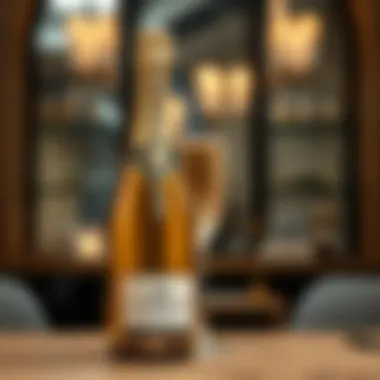Affordable Champagne Brands That Impress


Intro
When it comes to sparkling wine, many people think that a hefty price tag is synonymous with quality. But that notion is as misleading as it gets. Affordable champagne can deliver exquisite flavor and sophistication without breaking the bank. This guide digs into various inexpensive champagne brands that challenge the myth that high-quality bubbly has to come at a premium.
While champagne's rich history might seem steeped in pomp and grandeur, its enjoyment should be inclusive, not elitist. By focusing on what matters most — taste and value — you can find bottles that surprise your palate without lightening your wallet.
Let’s explore what makes a champagne worthy of your attention, the defining characteristics that set apart the best affordable options, and how to pick them out in shops. After all, indulging in a glass of bubbly doesn’t have to stay in the realm of luxury; it can become an everyday pleasure.
Understanding Champagne
In the vast world of wines, Champagne holds a special place of honor. Knowing its ins and outs can elevate your appreciation, particularly when it comes to exploring budget-friendly options. This section lays the groundwork for understanding not just what Champagne is, but why it matters, especially for those seeking flavor without breaking the bank.
The Origin of Champagne
Champagne hails from the northeastern part of France, specifically the Champagne region. It’s more than just a drink; it carries centuries of history and tradition. The birth of this sparkling wine dates back to the early 17th century, when winemakers began experimenting with fermentation. The climate, soil, and grape varieties here—like the famous Chardonnay, Pinot Noir, and Pinot Meunier—play intricate roles in its distinct flavor profile.
In understanding Champagne's origin, you also embrace its cultural significance. It is often a drink associated with celebration and elegance, rooted deeply in French etiquette. So when you opt for an affordable Champagne, you're not just choosing a budget option; you’re engaging with a rich history that has stood the test of time.
The Production Process
Producing Champagne is no simple feat; it requires precision and a respect for tradition. The method of creating this alcohol is known as the "Méthode Champenoise." It involves a secondary fermentation in the bottle, which gives Champagne its characteristic bubbles. This process can last years, influencing both the complexity and flavors of the final product.
One key step is the blending of different grape varieties and vintages to achieve balance and consistency. This meticulous approach can often be found in non-vintage options, which allow winemakers to maintain a standard taste each year. Understanding these nuances is crucial, especially when you’re in the market for a sparkling deal that doesn't compromise on taste.
Types of Champagne
When it comes to champagne, familiarity with its varied types can help you select the right bottle for your occasion. Let’s delve deeper into the three major categories: Non-Vintage, Vintage, and Prestige Cuvée.
Non-Vintage
Non-vintage Champagne is the workhorse of the sparkling wine world. It blends wines from multiple years to create an approachable and consistent flavor profile. A critical characteristic of non-vintage Champagne is its accessibility; you can find it at a variety of price points, making it a popular choice among those exploring affordable options.
The unique feature of non-vintage is its ability to deliver a balanced taste year after year. It's crafted for enjoyment rather than investment, allowing those who may not be affluent to partake in the charm of Champagne. One downside, however, is that it might lack the complexity of vintage options, but for casual consumption, it stands strong.
Vintage
Vintage Champagne is produced from grapes harvested in a specific year that must exhibit exceptional quality—something fairly rare in the Champagne world. This method reflects the climate conditions and the terroir of that specific year, giving it a unique signature. What shines in vintage Champagne is its depth and richness, often regarded as a treat for more discerning palates.
However, these bottlings usually come at a higher price point, potentially straying from the goal of finding inexpensive options. They can be delightful to savor on special occasions, making them rewarding purchases, but may not be the best fit if you're looking to stock your cellar sustainably.
Prestige Cuvée
Prestige Cuvée represents the pinnacle of Champagne production, with only the finest grapes selected from privileged sites. Often associated with renowned brands like Dom Pérignon or Krug, this type is crafted for excellence and craftsmanship. The key characteristic is its superior quality and often age-worthy nature; many drinkers choose to cellar these wines for later enjoyment.
While Prestige Cuvée can be a thrilling choice for celebrations, these wines typically flaunt a hefty price tag, which might not align with the aim of finding budget-friendly options. Yet, for those special milestones, a bottle of Prestige Cuvée could serve as a hallmark of celebration that’s well worth it.


"Each sip of Champagne can tell a story of craftsmanship, tradition, and nostalgia."
Understanding these types gives you the knowledge to make informed choices that can match your budget while savouring delightful flavours.
Assessing Value in Champagne
When it comes to champagne, the belief often prevails that you have to cough up a good amount of cash to get something worth drinking. However, assessing the value in champagne means looking beyond the price tag. This section shines a spotlight on the delicate balance between cost and quality, encouraging the reader to embrace the diversity in champagne options available today.
In today’s market, a stream of affordable options challenges this notion, making it crucial for consumers to understand what they’re getting for their hard-earned dollars. A comprehensive examination of various factors influencing pricing not only empowers buyers to make informed choices but also helps them appreciate the broader essence of champagne enjoyment without breaking the bank.
Price vs. Quality
Price remains the classic yardstick for evaluating quality, but this approach can be misleading. Just because something carries a hefty price tag doesn’t mean it’s of superior quality. Likewise, inexpensive options might surprise even the most discerning palates.
This dichotomy exists largely due to brand perception, marketing, and historical significance. Renowned brands often invest heavily in marketing, which can inflate their prices. On the other hand, newer or lesser-known brands may focus on producing exceptional products at lower costs—offering a delightful taste journey. To navigate these waters, consumers would do well to taste various champagnes, allowing their palate to guide their choices rather than relying solely on price.
As a general rule of thumb, look for champagne that dazzles the taste buds, with bright acidity, complexity, and the effervescence that invigorates the senses. If you find a bottle priced reasonably with those characteristics, you may have just hit the jackpot.
Factors Affecting Pricing
Understanding the factors affecting pricing is crucial in making a wise decision when selecting affordable champagne.
Region
The region where champagne is crafted plays a significant role in its character and price. Regions outside the famous Champagne district, like Burgundy or the Loire Valley, produce sparkling wines that often mimic the qualities of Champagne without the premium pricing.
For instance, wines from the Crémant d'Alsace region or Prosecco from Italy can offer a refreshing taste profile with a much lighter hit on the wallet. This geographical diversity provides a unique feature of sparkling wine: a blend of distinct flavors that often reflect their locale. Consumers inclined toward exploration can seek these alternatives and revel in delightful discoveries.
Grapes Used
The grape varieties utilized in the production process can also greatly affect the final cost of champagne. Traditional Champagne uses three main grapes: Chardonnay, Pinot Noir, and Pinot Meunier. Each grape lends its flair, and the proportions dictate overall flavor.
When lesser-known grapes, like Petit Meslier or Arbanne, enter the picture, a distinct flavor profile emerges. Cava from Spain, often made from the indigenous grape varieties such as Macabeo, Xarel-lo, and Parellada, not only provides a great taste but typically comes with a friendlier price tag. Buyers can benefit from exploring these options, as they uncover delightful treasures while sticking to their budgets.
Production Volume
The production volume certainly impacts pricing. Typically, smaller producers might offer unique flavors but can charge less due to their relatively low operational overhead. At the same time, larger houses with a high production capacity may position themselves at a premium owing to their reputation.
This opens up a fascinating conversation about scarcity versus abundance. Scarce products might result in a price bump, while more abundantly produced wines can be budget-friendly. Exploring the spectrum between artisan-crafted bottles and well-known brands can provide a well-rounded tasting experience without compromising on quality or draining the wallet.
Keeping these elements in mind can indeed facilitate a better understanding of champagne value. Ultimately, it all circles back to personal taste and the sheer enjoyment of discovering sparkling wines without excessive financial burden.
Inexpensive Champagne Brands Overview
In the realm of sparkling wines, the term "inexpensive champagne brands" often raises eyebrows. The conventional wisdom suggests that a high price tag correlates with quality. Yet, this notion limits many potential enthusiasts who may not be keen on breaking the bank just for a taste of bubbly bliss. In this section, we unravel the significance of inexpensive brands, revealing both their charm and practicality. Understanding these options helps to widen the palate while protecting the wallet, essential aspects that resonate with discerning consumers.
Why Choose Inexpensive Options?


Accessibility
The most immediate advantage of seeking out inexpensive champagne options is their accessibility. Unlike the rarefied vintages that demand respect and often a hefty price, these more affordable choices can often be found in local wine shops or even supermarkets. This convenience opens up the world of champagne to the average consumer, allowing everyone from casual sippers to budding connoisseurs to partake. Buying champagne shouldn’t feel like a high-stakes gamble; it should be an approachable experience. The beauty of accessibility lies in its ability to democratize enjoyment, urging drinkers to explore without financial strain.
Taste Diversity
When exploring inexpensive champagnes, you’ll encounter a rich tapestry of flavors that speak to various palates. Many of these brands put forward unique blends that reflect specific terroirs or innovative production techniques. This taste diversity means you can easily find something that suits your occasion or culinary pairing. Think of it like a treasure hunt: each bottle might surprise you with unexpected notes, whether it’s apple crispness or toasted brioche. This attribute makes affordable options an excellent choice for cheerful gatherings, where trying new flavors elevates the experience without causing stress over the cost.
Notable Affordable Brands
Brand A
Brand A has carved out a niche in the realm of value-oriented champagnes. Known for its consistently refreshing flavor profile, this brand is a favorite among both aspiring enthusiasts and seasoned drinkers alike. The particular hint of citrus it offers gives a nice zest to any celebration, making it particularly appealing for summer garden parties. However, the downside is that the finer nuances might get overshadowed in raucous gatherings, as its subtler notes require focused tasting to truly appreciate.
Brand B
With Brand B, you find a balance between price and quality. This brand prides itself on using traditional methods while remaining affordable. Many appreciate its round body and notes of stone fruit, which can complement a variety of foods beautifully. Its wide availability makes it a go-to for many, especially during holiday seasons. The trade-off? It might lack the complexity of higher-end options, but that simplicity can often be a breath of fresh air in a world of overly intricate wines.
Brand
Brand C has made quite the splash with its playful varietals that deliberately stray from the traditional. Offering a lively effervescence coupled with hints of raspberry and floral undertones, this brand’s charm lies in its unconventional approach. Perfect for celebrations where a departure from the norm is welcomed, it can get folks talking. Yet, a drawback is that such distinct flavors might not appeal to everyone’s taste, leading to a more acquired preference.
Through these explorations of inexpensive champagne brands, we can better appreciate the accessibility and diversity they provide. In a world where champagne is often linked to opulence, these selections illuminate the truth: enjoying bubbly doesn’t have to come at a premium.
Tasting Notes and Recommendations
Understanding the flavor and character of inexpensive champagnes is paramount for anyone looking to enjoy quality sparkling wine without breaking the bank. Through tasting notes, consumers can gather insight on what to expect from each bottle. Furthermore, recommendations on pairings and occasions help to elevate the experience, ensuring that each sip resonates with not just the palate but also enhances moments in life.
Tasting notes provide essential details, from the aromas that waft as the cork pops, to the delicate bubbles that tickle the taste buds. These nuanced descriptors guide enthusiasts as they explore various brands, focusing on richness, acidity and finish. A well-articulated tasting note helps demystify each option, ensuring you pick a champagne that truly hits the spot.
By diving into these factors, one can appreciate how taste contributes to the overall enjoyment, making informed choices rather than relying on mere marketing. The experience is not always just about the price tag; it’s very much about the unique qualities that each bottle unveils.
Flavor Profiles of Various Brands
Different brands of inexpensive champagne can offer rich complexity despite their affordability. For example, La Marca Prosecco is known for its refreshing notes of green apple and honeysuckle, creating a bright and crisp profile perfect for casual gatherings. On the other hand, Freixenet Cava presents a more earthy taste, with toast and nutty undertones woven through its flavor.
Another noteworthy mention is Mumm Napa’s non-vintage brut, showcasing a delightful mix of peach and citrus notes, which harmonizes well with light dishes or even on its own. Each of these brands embodies its own distinctive flair, ensuring there is something to cater to various palates and occasions.
Pairing Suggestions
Food Pairings
When it comes to food pairings, the versatility of champagne shines through. A broad array of flavors in inexpensive options means you can match them with an equally diverse selection of dishes. Consider pairing a fruity champagne, like Asti Spumante, with spicy Asian cuisine. The sweetness balances the heat beautifully.
For a more savory pairing, try a brut-style champagne with creamy pasta dishes or buttery seafood, which cut through the richness with its acidity, enhancing the meal without overshadowing the inherent flavors.
The unique feature of food pairings with these champagnes lies in how they can elevate simple meals into festive experiences. However, it is essential to keep the flavor balance – a too-sweet champagne can muddle a delicate dish, while an overly dry option may clash with richer food.


Occasion Recommendations
Regarding occasion recommendations, inexpensive champagne holds a significant advantage in its accessibility for various celebrations. Whether it be a birthday, a casual Friday night dinner, or an informal wedding toast, it provides a sparkle to any gathering without the fear of splurging.
Choose a versatile bottle, such as Prosecco, which works wonders at brunches or casual picnics. The effervescence brings a festive air, and its affordability ensures that all guests can partake in the toast. On the flip side, during more formal events, Taittinger Brut La Française could be a delightful selection, fitting effortlessly into any elegant setting.
The beneficial aspect of having these recommendations is that it allows hosts to focus on the gathering's spirit rather than the cost. Enjoying champagne during life’s moments makes each occasion a little bit brighter.
Shopping Tips for Inexpensive Champagne
When you're on a quest for bubbly without breaking the bank, shopping wisely is paramount. Understanding where and how to buy inexpensive champagne can significantly enhance your experience. In this section, we will explore various avenues for purchasing champagne, how to navigate the landscape, and why these tips can lead to finding great options at a fraction of the price.
Where to Purchase
Wine Shops
Wine shops often serve as treasure troves for those seeking affordable champagne. These specialty stores usually carry a curated selection of wines that can include local and lesser-known brands. One key characteristic of wine shops is the expertise of their staff. They tend to be passionate about their selections and can offer insights into brands that deliver excellent value, highlighting the nuances of various bottles.
The unique feature of wine shops is the sense of community they foster. Many have regular tastings, providing an opportunity to try before you buy. It’s also possible to discover limited editions or seasonal offerings that bigger retailers might not stock. However, it’s important to keep in mind that prices can vary significantly based on location and the shop's sourcing practices, so doing a bit of homework can help you find the best deals.
Online Retailers
The rise of online shopping has revolutionized how we buy champagne. Online retailers often boast a wider selection than local shops, allowing consumers to browse brands and prices from the comfort of their homes. A critical aspect of these retailers is the convenience factor; often, you can order a bottle and have it delivered right to your door.
While you may find competitive pricing online, be mindful of shipping costs, which can balloon your final bill. That said, many online retailers offer free shipping on a minimum purchase or during special promotions, making it worthwhile to compare options. Additionally, reading customer reviews can help you gauge the quality of lesser-known brands before you commit.
Supermarkets
Supermarkets have become a go-to option for many who want to pick up champagne along with their groceries. One of the main advantages of buying champagne at supermarkets is accessibility. Most people shop there regularly, and a good supermarket often has a decent wine aisle, including some budget-friendly bubbly.
The unique characteristic of supermarkets is their frequent sales and loyalty programs that can lead to significant savings. They might not have the same level of expert help as a wine shop, but the selection can still provide some value finds. On the downside, the quality may be hit-or-miss, especially with private label brands. It’s worthwhile to check labels and perhaps consult online reviews before purchasing.
Reading Labels and Reviews
When it comes to selecting champagne, knowing how to read labels and reviews can enhance your shopping experience. Labels can tell you a lot about the wine, including its origin, grape variety, and sweetness level. Understanding these elements can guide your choices and help you avoid any unwanted surprises.
Also, leveraging consumer reviews can provide insight into the taste and quality of a champagne brand before making a decision. Websites like Vivino and Wine Enthusiast offer user-generated reviews that can demystify your options. This way, you can feel more confident that you're not only getting a decent price but also a delightful bottle to enjoy.
Epilogue: Enjoying Affordable Champagne
The journey through the effervescent world of affordable champagne offers a fresh perspective on wine appreciation. Many imagine that celebrating with quality sparkling wine has to come with a hefty price tag—this sentiment is remarkably misplaced. An exploration of inexpensive options reveals wines that don't skimp on flavor or experience, encouraging a broader audience to indulge in champagne without the associated guilt of overspending.
Not only does this guide highlight the different brands and what makes them stand out, but it also breaks down misconceptions that surround budget-friendly bottles. Accessibility becomes a central theme; enjoying good champagne should not be an elite privilege. It should, instead, be an inclusive indulgence for all.
Considerations around value become paramount here. A lesser-known brand from the Montagne de Reims region might pleasantly surprise even the most seasoned champagne aficionado. For those launching into the world of bubbly, understanding these affordable wines brings with it not just savings, but also a richer tasting experience. There is a wide diversity of flavors that can cater to personal preferences, making champagne an exciting field for exploration.
"Just because the price is low doesn't mean the wine lacks soul. Each bottle carries a story and a passion that many overlook in their quest for prestige."
As we embrace the future of affordable champagne, we find ourselves standing at a crossroads of possibilities. The evolving marketplace suggests that brands are paying more attention to quality and innovation while retaining a consumer-friendly price point. We're seeing boutique producers challenging established names, aiming to carve a niche that celebrates originality in champagne production.
There’s also a growing trend where established wineries are launching second labels that offer an excellent balance of quality and cost. This movement attracts a younger demographic, keen on organic and sustainable practices. Their willingness to experiment with flavors and techniques ensures that the landscape of affordable champagne remains vibrant and appealing.
In essence, enjoying affordable champagne is not just about finding a good deal; it’s about appreciating what’s on your glass. The bonds we create over a shared bottle often mean much more than the cost it carries. So, here’s to finding joy in every sip, regardless of the price tag. In the end, what makes champagne special is not the expense but the moments it helps us celebrate.



